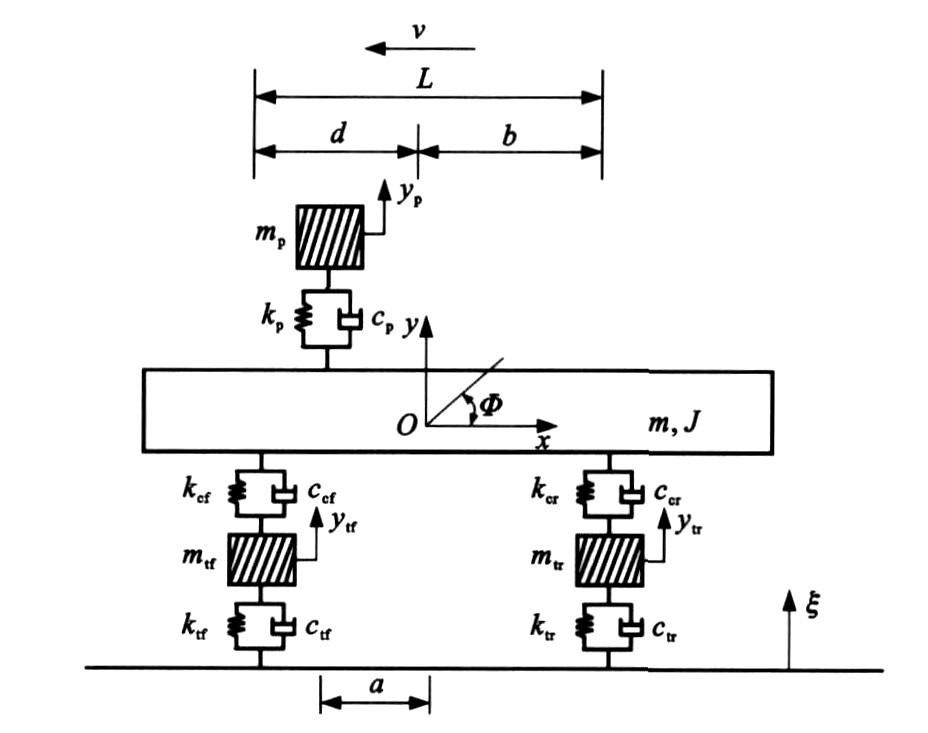Evaluation method of pavement roughness based on 5-DOF human-vehicle-road vibration model
-
摘要: 为了准确评价路面的行车舒适性, 以乘客的竖向加权加速度均方根值作为平整度评价指标, 采用五自由度振动模型, 考虑车路耦合, 用传递矩阵法进行了人-车-路相互作用分析, 研究了车速、车架转动惯量、座椅刚度系数和阻尼系数以及轮胎的刚度系数对加权加速度均方根值的影响, 并建立了基于人-车-路相互作用的路面平整度评价方法。算例结果表明: A、B、C、D四个等级路面的加权加速度均方根值分别为0.3812、0.7963、1.2320和2.9706 m.s-2, 舒适性评价分级与路面分级时的主观评价分级相一致; 相对于现有方法, 该方法考虑了不同路面类型和行车速度的影响, 体现了车辆的转动, 可评价货车行驶的舒适性。Abstract: To evaluate the riding comfort of pavement, human-vehicle-road interaction was analyzed by using transfer matrix method, in which the vertical weighted root-mean-square(RMS)acceleration of passenger was adopted as the evaluation index of pavement roughness, a 5-DOF vibration model was used, and the coupled interaction between vehicle and road was considered.The effects of running speed, rotary inertia of vehicle body, spring constant and damping constant of seat, and spring constant of tire on RMS were discussed, an evaluation method of pavement roughness based on human-vehicle-road interaction was proposed and an example was given.The RMS accelerations of the pavements graded A, B, C and D were 0.381 2, 0.796 3, 1.232 0 and 2.970 6 m·s-2 respectively, and the ratings of riding comfort of the pavements were correspondent with their subjective ratings.Compared with the existing evaluation methods of pavement roughness, the evaluation method considers the impacts of pavement types and vehicle speeds, reflects the impact of rotating of vehicle, and can evaluate the riding comfort of truck.
-
表 1 座椅刚度系数的影响
Table 1. Effect of seat stiffness coefficient
kp/(104N·m-1) 1.0 1.5 2.5 4.0 6.0 aw/(m·s-2) 0.938 0 0.836 7 0.766 4 0.700 3 0.867 7 表 2 座椅阻尼系数的影响
Table 2. Effect of seat damping coefficient
cp/(N·s·m-1) 50 100 300 500 1 000 10 000 aw/(m·s-2) 0.703 2 0.816 1 0.776 2 0.754 3 0.715 0 0.695 2 表 3 速度的影响
Table 3. Effect of running speed
v/(m·s-1) 20 40 60 80 100 120 aw/(m·s-2) 0.204 0 0.317 1 0.458 7 0.496 3 0.535 4 0.552 7 表 4 前轮胎刚度系数的影响
Table 4. Effect of stiffness coefficient for front tire
ktf/(105N·m-1) 5 9 20 60 100 aw/(m·s-2) 0.772 6 0.844 5 0.856 3 0.845 9 0.842 5 表 5 后轮胎刚度系数的影响
Table 5. Effect of stiffness coefficient for rear tire
ktr/(105N·m-1) 5 9 20 60 100 aw/(m·s-2) 0.775 1 0.627 8 0.598 2 0.578 9 0.576 0 表 6 转动惯量的影响
Table 6. Effect of moment of inertia
J/(kg·m2) 500 2 000 5 000 15 000 50 000 aw/(m·s-2) 0.603 7 0.796 3 0.494 7 0.442 9 0.438 4 表 7 加权加速度均方根值与行车舒适性的关系
Table 7. Relationship between weighted RMS acceleration and riding comfort
加权加速度均方根值/(m·s-2) 人体的舒适程度 0.315 保持舒适 0.315~0.63 稍不舒适 0.5~1.0 有些不舒适 0.8~1.6 不舒适 1.25~2.5 非常不舒适 > 2.0 特别不舒适 表 8 五自由度模型参数
Table 8. Parameters of 5-DOF model
mp/kg 53 mtf/kg 180 mtr/kg 210 m/kg 1 770 J/(kg·m2) 1 988 kp/(N·m-1) 19 030 kcf/(N·m-1) 51 000 ktf/(N·m-1) 571 420 kcr/(N·m-1) 89 600 ktr/(N·m-1) 571 420 cp/(N·s·m-1) 170 ccf/(N·s·m-1) 4 770 ccr/(N·s·m-1) 1 053 a/m 0.183 b/m 0.947 d/m 1.353 L=d+b=2.300 m 表 9 评价结果
Table 9. Evaluation result
路面等级 加权加速度均方根值/(m·s-2) 人的主观感受 A 0.381 2 稍不舒适 B 0.796 3 有些不舒适 C 1.232 0 不舒适 D 2.970 6 特别不舒适 -
[1] TRB. Guide for mechanistic-empirical design of new and rehabilitated pavement structures[R]. Washington DC: TRB, 2004. [2] 周晓青. 机场道面平整度评价指标研究[D]. 上海: 同济大学, 2006.ZHOU Xiao-qing. Research on the evaluation of pavement roughness indexfor airports[D]. Shanghai: Tongji University, 2006. (in Chinese) [3] PAPAGIANNAKIS A T, RAVEENDRAN B. International standards organization-compatible index for pavement roughness[J]. Transportation Research Record, 1998(1643): 110-115. [4] AWASTHI G, SINGH T. Roughness of pavement surfaces[D]. Kanpur: Indian Institute of Technology Kanpur, 2001. [5] ASTM STP 929, the tire pavement interface[S]. [6] TODD K B, KULAKOWSKI B T. Simple computer models for predicting ride quality and pavement loading for heavy trucks[J]. Transportation Research Record, 1989(1215): 137-150. [7] ASTM STP 1164, vehicle, tire, pavement interface[S]. [8] NEMMERS C J, GAGARIN N, MEKEMSON J. Assessing IRI vs. PI as a measurement of pavement smoothness[R]. Columbia: Missouri Transportation Institute and Missouri Depart ment of Transportation, 2006. [9] DELANNE Y, PEREIRA P A A. Advantages and limits of different road roughness profile signal-processing procedures applied in Europe[J]. Transportation Research Record, 2001(1764): 254-259. [10] 李志刚, 邓学钧. 高速公路行驶质量评价指标FRN的探讨[J]. 公路交通科技, 2000, 17(4): 13-14. https://www.cnki.com.cn/Article/CJFDTOTAL-GLJK200004004.htmLI Zhi-gang, DENG Xue-jun. Discussion for rideability number of freeway[J]. Journal of Highway and Transportation Research and Development, 2000, 17(4): 13-14. (in Chinese) https://www.cnki.com.cn/Article/CJFDTOTAL-GLJK200004004.htm [11] YU J, CHOU E Y, YAU J T. Development of speed-related ride quality thresholds using international roughness[J]. Transportation Research Record, 2006(1974): 47-53. [12] HASSAN R A, Mc MANUS K. Assessment of interaction between road roughness and heavy vehicles[J]. Transporta-tion Research Record, 2003(1819): 236-243. [13] BS 6841—1987, guide to measurement and evaluation of human exposure to whole-body mechanical vibration and repeated shock[S]. [14] ISO 2631-1—1997, mechanical vibration and shock—evaluation of human exposure to whole-body vibration—part1: general requirement[S]. [15] 马荣贵, 宋宏勋, 来旭光. 激光路面平整度检测系统[J]. 长安大学学报: 自然科学版, 2006, 26(2): 38-41. https://www.cnki.com.cn/Article/CJFDTOTAL-XAGL200602009.htmMA Rong-gui, SONG Hong-xun, LAI Xu-guang. Pavement roughness measurement system based on laser displacement sensors[J]. Journal of Chang an University: Natural Science Edition, 2006, 26(2): 38-41. (in Chinese) https://www.cnki.com.cn/Article/CJFDTOTAL-XAGL200602009.htm [16] 李炜明, 朱宏平, 黄民水, 等. 路面随机谱激励的数值计算方法及统计特征[J]. 中国公路学报, 2009, 22(3): 20-25. https://www.cnki.com.cn/Article/CJFDTOTAL-ZGGL200903003.htmLI Wei-ming, ZHU Hong-ping, HUANG Min-shui, et al. Numerical calculation methods and statistics characters on road surface random spectral excitation[J]. China Journal of Highway and Transport, 2009, 22(3): 20-25. (in Chinese) https://www.cnki.com.cn/Article/CJFDTOTAL-ZGGL200903003.htm [17] 余志生. 汽车理论[M]. 第5版. 北京: 机械工业出版社, 1989.YU Zhi-sheng. Automobile Theory[M]. 5th Edition. Beijing: Mechanical Industry Press, 1989. (in Chinese) [18] SAYERS M W, GILLESPIE T D, QUEIROZ C A V. The international road roughness experiment: establishing correlation and calibration standard for measurements[R]. Washington DC: The World Bank, 1986. [19] GB/T7031—2005, 机械振动道路路面谱测量数据报告[S].GB/T7031—2005, mechanical vibration—road surface profices—reporting of measured data[S]. (in Chinese) [20] 钟阳, 刘季. 路面车辆随机动荷载理论分析[J]. 工程力学, 1993, 10(4): 26-31. https://www.cnki.com.cn/Article/CJFDTOTAL-GCLX199304003.htmZHONG Yang, LIU Ji. Theoretical analysis of random dynamic load between road and vehicle[J]. Engineering Mechanics, 1993, 10(4): 26-31. (in Chinese) https://www.cnki.com.cn/Article/CJFDTOTAL-GCLX199304003.htm -





 下载:
下载:


